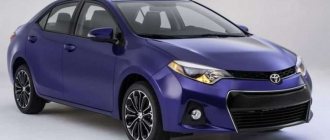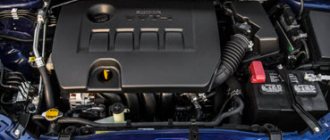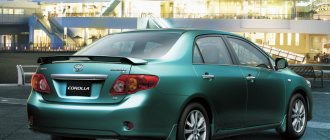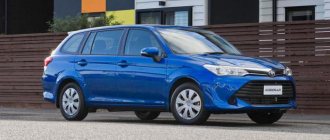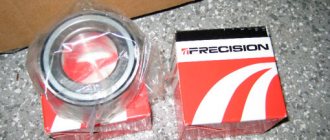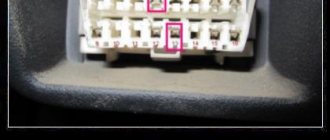Reviews
After the completion of production of the fifth generation, the Japanese released the sixth generation Toyota Corolla, index E90. The car entered the assembly line in 1987 and was produced until 1993, while production of the seventh generation began in 1991. Sales continued for the Australian market, where the model was called the Holden Nova, and North America, the Geo Prizm.
Buyers demanded more comfort and premium, so engineers worked in this direction, forgetting about motorsport, where its predecessor was very popular. Sales were higher - 4.5 million models.
Plus one body
At the request of buyers and due to the increase in the size of the car, it was possible to achieve the style of the Mark 2 - a luxury car for those times. The body acquired a more rounded shape, but in many ways remained square.
6 bodies were produced, a station wagon was added. There remains a visual difference between each body and each other. Dimensions also vary, but the 243cm wheelbase unites them.
Corolla E90 sedan:
- length – 4195 mm;
- width – 1655 mm;
- height – 1365 mm;
- ground clearance - 155 mm.
Hatchbacks:
- length – 3995 mm;
- width – 1655 mm;
- height – 1365 mm;
- ground clearance - 155 mm.
Station wagon:
- length – 4205 mm;
- width – 1605 mm;
- height – 1435 mm;
- ground clearance - 155 mm.
Coupe:
- length – 4245 mm;
- width – 1680 mm;
- height – 1300 mm;
- ground clearance - 150 mm.
Liftback:
- length – 4214 mm;
- width – 1654 mm;
- height – 1364 mm;
- clearance – 152 mm.
Body Features
A liftback is a body type that occupies a middle position between a hatchback and a sedan, and combines their main advantages and disadvantages. What it has in common with the first is primarily the length of the rear overhang, which is longer than that of a hatchback, and its shape. From the second, the liftback borrowed the Toyota Corolla trunk door, which opens along with the rear window. It is often difficult to distinguish a sedan from a liftback by appearance, especially when the tailgate is closed. In this case, you should pay attention to the glass above the trunk lid - in the liftback it is equipped with a wiper.
For cars in this version, neither strict regulations nor precise classification were prescribed. For this reason, manufacturers of passenger cars of this type have the right to classify them as liftbacks, as well as sedans or hatchbacks. For example, the popular Liftback Toyota Corolla car in the 120 body (ninth generation) is often classified as a five-door hatchback.
The main advantages of models in this body version:
- The trunk volume of liftbacks and sedans is approximately the same due to the length of the rear overhang. The design of the door allows you to place even bulky items inside the luggage compartment, and also greatly facilitates loading and allows it to be done from the side, which is convenient in tight parking conditions.
- Most liftbacks of the Corolla family are short in length, which makes it easier for the driver to park, even if there is little free space.
Interior innovations
The interior has become more spacious, and the design has become more comfortable. The car was sold in four trim levels: XL, GL, SE, SE Limited. The basic version had a 2-spoke steering wheel, the radio was installed in the upper part of the console, connected to the instrument panel. The climate was regulated by 4 sliders. At the top, the steering wheel became 3-spoke, and the upper part of the console received three additional sensors. The radio of the sixth Corolla was moved down, and the climate unit remained with two sliders; the rest of the functionality was replaced with buttons.
Velor began to be used as lining. The developers actively studied the desires of consumers, coming to the conclusion that this is the kind of material in different colors that the public wants.
Toyota pioneered the study of noise reduction, knowledge that allowed it to optimize body shape, use sound insulation and achieve better silence than before.
Toyota Corona IX generation T190
In our country it was called a “barrel”, in Europe it was sold as Carina E, but with a basic, so to speak, sedan body, it retained the liftback modification. In the Old World it was called Carina E Liftback. In Japan - Corona SF. The sloping rear door made the silhouette swift and elegant. Alas, such a 5-door version, a sort of Japanese Octavia of the 90s, was rarely available for sale.
Probably because such a “transitional” - cargo-passenger - modification was preferred by the station wagon. In European countries it was called either Carina E Wagon or Carina E Estate. In his homeland - Caldina, that is, for the first time he received a proper name.
Moreover, there was a Van version with spring rear suspension and leatherette interior. For some, such a spartan Caldina has become an “anti-crisis” car. In Primorye, Siberia, and the Urals, due to their cost, they were loved by taxi drivers and people in difficult life situations who needed a simple, cheap car with good cargo capabilities.
The Caldina was generally more fashionable than the sedan. Much more often they hung body kits on it, and something like kangurins, and they installed large “fog lights”. But from the point of view of factory interior equipment, now you will not find anything special in the Corona and its platform models. It's a different matter then. After all, a “broom” (aka “windshield wiper” on the rear window), air conditioning, electric windows, mirrors, and central locking were considered more than worthy equipment. On European classmates at this time, the windows were mainly lowered with “meat grinders”, and the sunroof was responsible for the “climate”. The differences in equipment boiled down to the presence of a tachometer (absent on the simplest ones) and the organization of climate control.
It is noteworthy that a variety of ergonomic experiments have remained in the recent past. By the advent of the ninth generation, all secondary controls were located in the places we are now familiar with. Thanks to its focus on the European market, Corona provided a comfortable fit not only for the slender Japanese. Although the back was not very spacious. But this is the general trend of those years. At least the Camry/Vista models next in the hierarchy were only a little more hospitable to rear passengers.
The paradox is that in the second half of the 90s and early 2000s, the Corona was often more expensive than these larger sedans. Despite the common units - engines, gearboxes - for some reason it was believed that our heroine was more reliable and durable than the Camry/Vista.
Engine
A lot of engines were offered, which also characterizes the beginning of the 90s as a time when investments were not particularly considered, but worked on a variety of technical modifications. On the other hand, Toyota at that time had a rich range of engines, and Corona, as a middle-class model, received units from both “bottom” and “top”. For example, the 1.6-liter 115-horsepower 4A-FE was one of the main ones for the Corolla family. 4S-FE (1.8 l, 125 hp) was installed on all front-wheel drive models and even on the basic versions of the Mark II and its clones. The 7A-FE (120 hp), which replaced it in a number of markets in 1994 and was equal in volume, was perhaps less widespread. Nevertheless, it also covered at least two segments. What can we say about the 2.0-liter 3S-FE and 3S-GE (135/140 hp and 165/175 hp; the latter was offered on EXIV, ED and Caldina), which (at least the first one) became for the Corona family as a motor basis.
Finally, in those days Toyota was not yet a fan of electric technology, and therefore a number of diesel engines were responsible for fuel economy - 2C, 2C-T, 3C (2.0 and 2.2 liters). Yes, they were only a stretch for the role of units for a D-class representative that was fashionable by those standards - with a power of 73–85 hp. provided too phlegmatic character. However, in Europe their presence was mandatory. And from Japan to Russia Corona with the most puny atmospheric 2C was transported reluctantly.
Transmission
Of the entire arsenal of systems already adopted by Toyota (TEMS, 4WS, 4WD), the Corona used only all-wheel drive with a symmetrical center differential locked by a multi-plate clutch.
Corona is simplicity itself. Firstly, it doesn’t have any extra tricky knots. Secondly, any engine (unlike, say, Vista/Camry, on which whimsical “sixes” were installed) is impeccable from a reliability standpoint. Is it possible that the 5E-FE, familiar from the “wooden” Caldina, was designed without a special resource reserve. The rest, and especially the S-series fours, required only gasoline. But they could have been patient with oil and other maintenance.
The main merit of the A240 series box is the same forgiving homeliness. It happened that it was cared for by particularly scrupulous owners for hundreds of thousands of km. And she maintained the adequacy of her work until the very end. This, of course, adjusted for the fact that it was created in the 80s with all the ensuing consequences. You always feel the gear change; to activate the kickdown mode, you need to press the pedal with all your heart. Then wait for the control unit to “see” your desire. Any 5- or 6-speed automatic transmission from the later ones is much faster and more obsequious.
Steering
Steering wheel with a clear zero and good reactive action, a tight, compact chassis? No, this is for the “Germans”. Corona captivates others. Her pendant, even being worn out into trash, still retains a bit of its delicacy. It rattles and clatters, but continues to provide an acceptable ride. If the chassis is more or less in order, like ours, the “barrel” literally becomes intelligent and courteous. Is it a bad bonus for a 25-year-old car that can be purchased for 150 thousand?
Bottom line
However, Corona 190 is now as valuable as ever. Of course, adjusted for the years that have passed. Unlike its classmates, many of which have long been turned into firewood, it does not rot, does not fall apart, and has retained a good residual life. Therefore, it is not uncommon to find specimens on sale valued at two or more hundred thousand rubles. Sometimes they ask for three hundred. This is perhaps overkill. Nevertheless, you can easily choose “your” copy.
Specifications
| Type | Index | Volume | Power | Torque | Cylinders/valves |
| Petrol | 2E | 1.3 l | 73 hp | 101 H*m | 4/12 |
| Petrol | 5A-F | 1.5 l | 85 hp | 123 H*m | 4/- |
| Petrol | 5A-FE | 1.5 l | 94 hp | 128 H*m | 4/16 |
| Petrol | 4A-F | 1.6 l | 91 hp | — | 4/16 |
| Petrol | 5A-FHE | 1.5 l | 105 hp | 132 H*m | 4/16 |
| Petrol | 4A-GE | 1.6 l | 120 hp | 142 H*m | 4/16 |
| Petrol | 4A-GE | 1.6 l | 140 hp | 147 H*m | 4/16 |
| Diesel | 1C-2 | 1.8 l | 64 hp | 118 H*m | 4/- |
| Diesel | 1C-2 | 1.8 l | 67 hp | 123 H*m | 4/- |
The range of engines consists of many engines of different power, there is even one diesel engine. The lineup can get confusing, so we have prepared a separate table with data for each engine.
There were 4 gearboxes in a pair - 4 or 5-speed manual, or 3 or 4-speed automatic. The box depends on the engine. The E90 Corolla switched to a front-wheel drive platform, which reduced its popularity in motorsport, but added more handling. Optionally, the Japanese became all-wheel drive - the rear axle on the mechanics received torque through a mechanical differential lock, on the automatic the differential was locked hydraulically.
The suspension was taken from its predecessor, changing the geometry, which added handling. Additionally, a modular TEMS suspension was installed, which changed the damping stiffness at the driver's request.
The brake system is disc at the front, drum at the rear. Only the sports version of the GT got back disc mechanisms.
All owner reviews about Toyota Corolla E90
Another year has passed... There were no surprises during the operation of TOYOTA (and I’m lying right away - there was one surprise). So, after receiving a sticker about passing the technical inspection, I, without fear of the police or a fine for its absence, was able to prance through the streets of dear Riga with a clear conscience...
Autumn passed as usual.
The winter of 2011 began quite systematically. And so in January (around the 10th) I refueled my horse and drove through the snowy streets, but I had to go to the service center. Not because I smoothed out the ice in the ruts with the bottom, giving the owners of “high-end” SUVs the opportunity to feel great, not because it wouldn’t start in severe frosts, not because the morning began with cleaning the road in the yard, and not even because -for the accident (pah-pah-pah)...Are you intrigued? I'll open the cards. She decided that she needed to eat more (they say, the owner has received a salary - feed him). Consumption increased to 15 liters per 100 km (this is from 8.3 liters per 100 km). When I discovered this fact, I was quite discouraged, but immediately began to suspect. After a night of sitting, I started it up, pulled out of the parking lot and looked at the tracks. There were 2 obvious thawed patches in the snow (as if walking into the snow). Here it is, I think, somewhere I leveled the track, pierced the fuel line - you need to take a Forester or HR-V, and then the Audi A3 and others with a low landing will grind the track. But the diagnosis was different. I ask the mechanic about the fuel leak, and he asks about the leak in the pump. Where does this expense come from? The technician checked the lambda probe (it turned out that there was one), it was fine. After 2 weeks, consumption by itself returned to normal levels of 8 liters (in winter), at the time of writing this review (September 2011) it is 7.5 liters per 100 km. around town. At the end of winter, the glass cracked along the entire length, exactly visually above the hood line. I would drive and drive, but I can’t express how annoying it is (some people are annoyed by the squeaking of polystyrene foam on glass, others can’t lick ice cream off a wooden stick, etc.). Having assessed the financial possibilities and the fact that I would still have to change the glass to undergo maintenance, I changed it (soon, however, my budget was shortened by exactly this amount - a cold is a dog). And in the glass on the passenger side, a small chip (about 1-1.5 mm) was found on a crack, it looked like it had come from under a truck, otherwise I suspected that the body was starting to wear out from old age. Again, there is a guess as to how this happened, but I will say this - don’t give the car to anyone. However, everything has passed, winter has passed, spring has and it’s already July.



